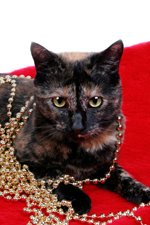|
Tortoiseshell CatsTortoiseshell cats show interesting color patterns, which resemble those of a tortoise shell (hence the name). The most common coloring is a combination of black and red patches. Other color combinations include chocolate and cream and blue and cream.
The complete explanation is a bit long and complicated, but basically the tortoiseshell pattern is caused by the inactivation of the X-chromosome. Interestingly, just like with calico cats, this pattern primarily happens in female cats. Torties (as tortoiseshell felines are affectionately called) are lovely and truly unique. I think that their coats look like exquisite tapestries and even abstract works of art. They are indeed beautiful animals.
Tortoiseshell color patternsAs I said before, the basic combination of a tortoiseshell cat is black and red (or orange). The dilution gene produces additional color variations (some of them quite interesting). Furthermore, the tortoiseshell color patterns can occur in different breeds, including Burmese, Abyssinian, and Siamese. A tortoiseshell tabby cat is known as a torbie. It's basically a tortie with stripes.A tortie’s coat does not show clearly defined patches of color. In the tortoiseshell pattern the two colors are mixed. Here are some tortoiseshell color combinations: Non-diluted patterns
Diluted Patterns The dilution gene causes a host of color variations, including: Fawn and cream, blue and cream and lavender and cream. Diluted torties exhibit muted or “washed off” colors. Tabby and tipped tortoiseshell The tabby pattern also occurs in tortoiseshells. These unique kitties are known as torbies or patched tabbies. The tortoiseshell tabby pattern also comes in different combinations, including red and black or black and silver. You will also find that the classic, spotted and mackerel tabby patterns also occur in tortoiseshells. In addition to the tabby pattern, you can also find torties that exhibit tipped markings. In this pattern, the coloring appears at the tip of the cat’s hairs.
Tortoiseshell and white Some torties have a larger amount of white fur than usual. However, these cats are not to be confused with calico cats. Calicos are true tricolor felines and their coats exhibit very distinct patches of three different colors. Torties, by contrast, do not have clearly defined patches of colors. Even when they exhibit white fur, it is usually in small quantities and the other two colors remain blended. Interestingly, in the UK calico cats are called tortoiseshell-and-white cats. Fun morselsCan you breed torties? According to the information I have found on this topic, you can actually breed torties. At least one of the parents must carry the O gene, which is closely linked to tortoiseshell cats. So now you know. Are these felines lucky cats? Tortoiseshell cats, just like calico cats, are believed to be bearers of good luck. Many cultures have torties in high regard. Some people even believe that tortoiseshell felines attract money. To me these are beautiful creatures that can bring their owners lots of love and affection. What is a torbie?
|
 Mia was lovely, courageous, and one of the wisest cats I've ever met. This site is dedicated to her memory.
Mia was lovely, courageous, and one of the wisest cats I've ever met. This site is dedicated to her memory.
Max
 Max is our very own magical cat. He loves big mouse toys and is an avid bird watcher.
Max is our very own magical cat. He loves big mouse toys and is an avid bird watcher.






 So what causes this particular color pattern? The tortoiseshell cat coloring is a result of genetics.
So what causes this particular color pattern? The tortoiseshell cat coloring is a result of genetics. 